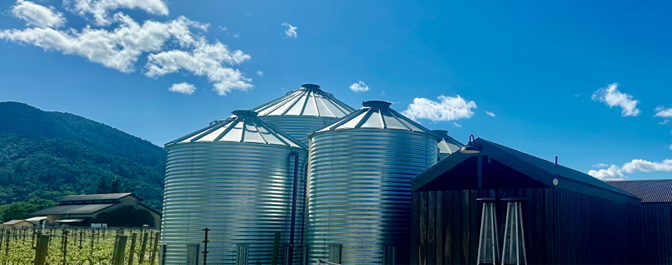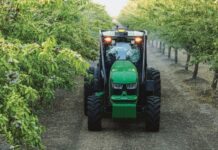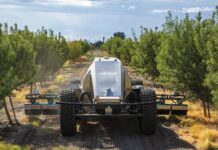
At Paso Robles’ Eberle Winery, a large reed bed in a constructed wetland chomps on winery wastewater bacteria.
In the Sierra Foothills in Placer County, Wise Villa Winery’s BioFiltro worm bin, the size of a shipping container, is home to millions of worms consuming wood chips and wastewater. Winery staff can remotely monitor how much water the winery is pumping through the system as well as monitor the water’s pH on their cell phones.
Wine industry giant O’Neill uses the same (scalable) technology at its mammoth production site in the Central Valley, growing alfalfa with the recycled irrigation water the system generates and feeding the crop to its herd of cattle.
On 8th Street in Sonoma, Scribe’s new winery uses a Cloacina, a membrane biological reactor (MBR), to clean the wastewater from its new facility, sharing maintenance expertise with a neighboring winery and sending the clean water into Sonoma’s sewer system.
All these are solutions prompted by the need to comply with California’s existing and new discharge requirements for winery process water, which began requiring wineries to register with the state water board by Jan. 24, 2024.
To date, state data show a significant number of wineries have not submitted required plans.
While land-applied applications are the least costly method for discharging wastewater, some wineries prefer to use worm bin systems offered by BioFiltro, which recycle the process water. Minimum price is $150,000. Some opt for tank and haul if a municipal wastewater system will accept their rate and the trucking costs are not too high. Ponds and managed wetlands are other relatively lower-cost solutions. MBRs can cost $500,000 and require significant ongoing maintenance.
Revolutionary, Low-Cost Winery Wastewater Treatment System in Use
For One Hope in Napa, innovative wastewater engineering veteran Chris Ott, CEO of Hydros Agritech, designed a new in-pipe biological treatment system. Ott has been working on wastewater treatment for decades and formerly designed parts of one wine giant’s 3-million-gallon-per-day wastewater system (which generates a significant amount of energy for the company).
Ott found an interested client in Frank Kloberdanz, father of pioneering One Hope’s CEO and co-founder Jake Kloberdanz, who had just retired as construction manager at Stanford Environmental Health and Safety. The two met through the local animal rescue group.
While the regular winery wastewater order prohibits wineries from combining both human and winery wastewater streams, another type of permit, a general order for a small domestic treatment plant, allows it. The Hydros Agrotech system at One Hope is permitted as a small domestic treatment plant.
The new system routes wastewater through an extensive yet compact piping system with a proprietary mix of cleansing bacteria. The winery was able “to recapture about an acre of land,” said Kloberdanz.
That was significant for the property, which includes both the winery and adjacent residential units.

Said Ott, “All the wastewater from the winery, along with the domestic waste from the winery and all the wastewater from the house and a cottage, gets combined underground. And then there is a buffer tank and an equalization tank. The system takes all the water combined and kind of equalizes what’s in the water. Then we have sensors in there that activate the treatment system when there’s water to treat.”
“There’s bacteria that grows inside of the pipe, and that bacteria is what cleans the water,” Ott said.
The system has one large metal cistern for recycled water storage. The processing takes place in a small shed behind the winery.
“It’s low technology. It’s actually pleasing,” said Kloberdanz. “And we get a system that eliminates the need for all of the leach fields.”
The system’s water, when cleaned, ends up in the 15,000-gallon tank and gets used for landscape irrigation. “So instead of using well water for landscape irrigation, they’re using recycled water, preventing the need to pump from a well,” said Ott.
Ott is still tinkering to get even better results. “I can get better efficiencies out of a redesign very soon,” he said. “But part of the reason for this beta project basically is that we wanted to have a number of years of operation. So now I can say it’s been running for almost three years.”
Pricing is not yet available, but Ott said it would be a low-cost system. One Hope features the system on its regular wine tasting tours. Producers can also schedule a tour specifically to see the Agritech-powered wastewater facility. Contact information is available at www.hydrosagritech.com.
Other Vendor Innovations
Some wastewater technology companies are offering “wastewater processing as a service,” in which the company will bring equipment, including an MBR, for instance, on site for a day and return 90% of process water to the winery to re-use. Hydros Agritech’s solution may also be available as a service in the future.











